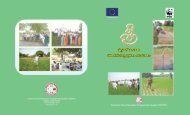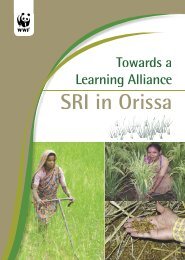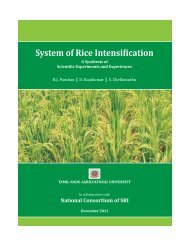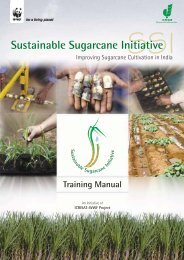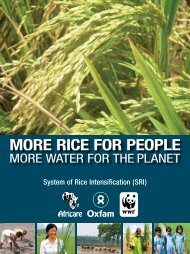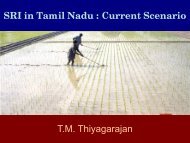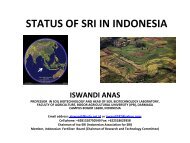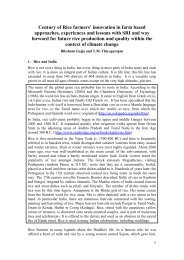SSI Newsletter - SRI - India
SSI Newsletter - SRI - India
SSI Newsletter - SRI - India
Create successful ePaper yourself
Turn your PDF publications into a flip-book with our unique Google optimized e-Paper software.
Minister with a<br />
farmer’s heart and soul<br />
The crisis in conventional sugarcane cultivation in Punjab<br />
has been becoming more and more acute every year. It is<br />
hardly surprising then that the farmers in the state are more<br />
than willing to experiment with the new method of <strong>SSI</strong> for<br />
improved production and overall productivity of sugarcane.<br />
Dr. Amrik Singh<br />
Shri. Sucha Singh Langah, who is 55<br />
years old, has been the Minister of<br />
Agriculture for the State of Punjab<br />
for the last 3 years. He is the owner<br />
of 25 acres of land himself and has<br />
taken up cultivation of sugarcane and<br />
rice among other crops, in his field.<br />
His introduction to the <strong>SSI</strong> methods<br />
came when he was invited to attend<br />
a four-day Agriculture Development<br />
Exhibition and Workshop, organized<br />
by the Agricultural Technology<br />
Management Agency (ATMA),<br />
Gurdaspur under the aegis of Dr.<br />
Amrik Singh, Deputy Project Director,<br />
ATMA, Gurdaspur who gave a detailed<br />
presentation of the <strong>SSI</strong> methods.<br />
Shri. Langah was so impressed with<br />
the possibilities of this new method<br />
that he decided to implement it on<br />
an experimental basis in 1½ acres<br />
The benefits – both short term<br />
and long term – of <strong>SSI</strong> were so<br />
easily apparent that Shri. Sucha<br />
Singh Langah, the Minister for<br />
Agriculture, Government of<br />
Punjab, who himself is a farmer,<br />
took up <strong>SSI</strong> in his fields and is<br />
today the greatest advocate of<br />
<strong>SSI</strong> in his state.<br />
Hon’ble Punjab Agriculture Minister<br />
Shri. Sucha Singh (right) with the Director<br />
General of ICRISAT, Dr. William Dar (left)<br />
during the <strong>SSI</strong> Training Manual release<br />
as a part of which he began the chip<br />
bud nursery in March of this year.<br />
He has been actively involved in the<br />
propagation of the <strong>SSI</strong> methods to<br />
other farmers in the state, bringing<br />
more and more focus through<br />
the media. His keen interest in <strong>SSI</strong><br />
prompted him to visit the ICRISAT-<br />
WWF Project office and meet the<br />
scientists to further enhance his<br />
knowledge. It was during this visit<br />
that he was able to participate in<br />
the official book release of the <strong>SSI</strong><br />
Trainer’s Manual.<br />
As the minister is new to this method,<br />
he has been encountering problems<br />
in implementing the <strong>SSI</strong> practices in<br />
the field. As he sowed his seedlings in<br />
late May, a little later than the other<br />
farmers, the growth of cane was slower,<br />
though the tillering is quite good at an<br />
average of 15 per clump, as against<br />
8-10 tillers in the conventional method.<br />
Speaking about the <strong>SSI</strong> methods and<br />
practices, Shri. Sucha Singh Langah<br />
says, “As a farmer and the Minister<br />
for Agriculture, I understand that <strong>SSI</strong><br />
is practically beneficial and will bring<br />
profits to the sugarcane farmers of<br />
Punjab”.<br />
Dr. Amrik Singh is the Deputy Project<br />
Director, ATMA at Gurdaspur<br />
Nov ‘09<br />
17<br />
SugarCane<br />
matters<br />
• Light earthing up is essential<br />
for increasing tillering. Proper<br />
compaction of earth near the stem<br />
is real earthing up or else there is<br />
no use of earthing up<br />
With certain precautions and<br />
balancing of activities – which<br />
comes naturally with experience -<br />
the technology can very well give a<br />
yield of 120-150 tonnes/ha, not only<br />
on experimental plots but on mass<br />
scale also. Wider spacing of rows<br />
eases the entire activity taken up, as<br />
the labourers have sufficient space<br />
for movement and reduced number<br />
of rows to work. Hence, <strong>SSI</strong> is a<br />
very easy to use and farmer friendly<br />
technology. Encouraged by the initial<br />
response, Triveni is now providing<br />
the raised plantlets to the farmers to<br />
plant in their own fields. In the next<br />
stage, the nursery raising activity will<br />
be taken up at the farmers’ field as<br />
part of the next phase as a strategy<br />
for scaling up this technology.<br />
Transporting coco pith from South<br />
<strong>India</strong> is the only concern, as it<br />
increases the cost of nursery raising.<br />
Already other alternatives to coco<br />
pith are being explored, which shall<br />
further reduce the cost.<br />
This technology is seen as a suitable<br />
and promising alternative to address<br />
the concerns of farmers, industry<br />
and the ecological activists. The<br />
Government agencies and Agriculture<br />
Universities should certainly adopt<br />
and take forward this technology,<br />
which has been invented by the<br />
farmers themselves.<br />
Encouraged by the results in the<br />
trial plots, Triveni is now scaling it up<br />
further in 60 ha under <strong>SSI</strong> this autumn,<br />
including about 50 ha in the farmers’<br />
fields. The nursery preparation has<br />
already been initiated and the planting<br />
will be done in November 2009.<br />
P.K. Singh is the General Manager (Cane),<br />
Triveni sugars



